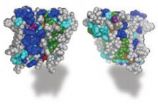(Press-News.org) HIV care centers are an important and highly accessed point of care for HIV-infected children and their families in sub-Saharan Africa, but opportunities to address other health issues are being missed. Proven interventions, including routine deworming among young children, could be effectively integrated into HIV care according to a newly published article in PLoS by University of Washington researchers.
The article, "Integration of Deworming into HIV Care and Treatment: A Neglected Opportunity," estimates that millions of HIV-infected individuals in sub-Saharan Africa are also infested with parasitic worms, called helminths. The parasitic infestations have enormous health consequences, including anemia, malnutrition, and impaired cognitive development, and may also increase the progression of HIV.
Helen Gerns, the lead researcher on the paper, said that the World Health Organization (WHO) recommends annual or bi-annual deworming of children in schools as a cost-effective strategy to diminish the consequences of chronic helminth infection. However, many children are not routinely being dewormed through programs in schools. This, despite the fact that standard treatment of soil-transmitted helminth infection entails only a single 400 mg dose of albendazole, making routine deworming of children a simple intervention. In addition to missing those children who are unable to attend school during deworming campaigns, school based deworming misses pre-school aged children.
"Annual deworming of preschool-aged children is safe and highly effective in reducing parasite prevalence and intensity, malnutrition, and risk of stunting, but a formal policy does not yet exist to target this age group," said the researchers. "Because children are infected and often diagnosed with HIV while very young, preschool-aged children can easily be dewormed in HIV clinics, along with their siblings, to reduce the occurrence of reinfection."
Deworming HIV-infected children may have additional benefits, including delaying the progression of HIV, reducing other infections, and increasing responsiveness to vaccines.
"Population-level data show that regional variations in vaccine efficacy correlate with variations in the prevalence of enteric [gut] pathogens," according to the article. The article cites increased efficiency in the rotavirus vaccine and polio eradication efforts in countries with fewer cases of helminth infections.
"Children who failed to respond to oral poliovirus vaccinations were 25 percent more likely to harbor infections with intestinal parasites than vaccine responders," according to the article.
"Given that deworming is standard medical care among all children in many settings, we should not miss such an effective, inexpensive and practical opportunity to deworm HIV-infected children," said co-author Dr. Judd Walson, assistant professor of global health at the University of Washington.
### This research was partially funded by a grant from the National Center for Research Resources of the National Institutes of Health (TL1 RR 025015) and by the UW Center for AIDS Research, Scientific Program on HIV and Co-infections.
Global health researchers urge integrating de-worming into HIV care in Africa
School-based programs not as effective in reaching children with infestations
2012-08-02
ELSE PRESS RELEASES FROM THIS DATE:
UCLA-led project aimed at African American couples affected by HIV gets $2.5 million boost
2012-08-02
A UCLA-led project to implement a unique HIV intervention program aimed at reducing sexually risky behaviors and promoting healthier living among heterosexual African American couples has received a $2.5 million grant from the National Institute of Mental Health.
The program, based on Eban — a Yoruban concept from West Africa that symbolizes "safety, security and love within one's family and community" — is designed not only to reduce the risk of HIV and other sexually transmitted diseases but to increase couples' ability to communicate with each other, make safer behaviors ...
Is it a rock, or is it Jell-O? Defining the architecture of rhomboid enzymes
2012-08-02
Johns Hopkins scientists have decoded for the first time the "stability blueprint" of an enzyme that resides in a cell's membrane, mapping which parts of the enzyme are important for its shape and function. These studies, published in advance online on June 14 in Structure and on July 15 in Nature Chemical Biology, could eventually lead to the development of drugs to treat malaria and other parasitic diseases.
"[It's] the first time we really understand the architectural logic behind the structure of the enzyme," says Sinisa Urban, Ph.D., an associate professor of molecular ...
Mending a broken heart -- with a molecule that turns stem cells into heart cells
2012-08-02
LA JOLLA, Calif., August 2, 2012 – For years, scientists have been looking for a good source of heart cells that can be used to study cardiac function in the lab, or perhaps even to replace diseased or damaged tissue in heart disease patients. To do this, many are looking to stem cells. Researchers at Sanford-Burnham Medical Research Institute (Sanford-Burnham), the Human BioMolecular Research Institute, and ChemRegen, Inc. have been searching for molecules that convert stem cells to heart cells for about eight years—and now they've found one. Writing in the August 3 issue ...
Genetic copy-number variants and cancer risk
2012-08-02
Genetics clearly plays a role in cancer development and progression, but the reason that a certain mutation leads to one cancer and not another is less clear. Furthermore, no links have been found between any cancer and a type of genetic change called "copy-number variants," or CNVs. Now, a new study published by Cell Press in The American Journal of Human Genetics on August 2 identifies CNVs associated with testicular cancer risk, but not with the risk of breast or colon cancer.
Some cancers, including breast and colon cancer, are caused by mutations that are passed ...
It's in our genes: Why women outlive men
2012-08-02
Scientists are beginning to understand one of life's enduring mysteries - why women live, on average, longer than men.
Published today in Current Biology, research led by Monash University, describes how mutations to the DNA of the mitochondria can account for differences in the life expectancy of males and females. Mitochondria, which exist in almost all animal cells, are vital for life because they convert our food into the energy that powers the body.
Dr Damian Dowling and PhD student, Florencia Camus, both from the Monash School of Biological Sciences, worked with ...
'Unhealthy' changes in gut microbes benefit pregnant women
2012-08-02
The composition of microbes in the gut changes dramatically during pregnancy, according to a study published by Cell Press in the August 3rd issue of the journal Cell. Although these changes are associated with metabolic disease under most circumstances, they could be beneficial in pregnant women.
"This is the first in-depth characterization of the gut microbiota associated with pregnancy," says senior study author Ruth Ley of Cornell University. "The findings suggest that our bodies have coevolved with the microbiota and may actually be using them as a tool—to help alter ...
Scripps Florida scientists identify a critical tumor suppressor for cancer
2012-08-02
JUPITER, FL – August 2, 2012 – Scientists from the Florida campus of The Scripps Research Institute have identified a protein that impairs the development and maintenance of lymphoma (cancer of the lymph nodes), but is repressed during the initial stages of the disease, allowing for rapid tumor growth.
While the study, published in the August 3, 2012 edition of the journal Cell, largely focuses on the role of this new tumor suppressor in lymphoma induced by Myc oncoproteins (the cancer-promoting products of Myc oncogenes), the authors show this circuit is apparently operational ...
Study finds mechanism that turns white fat into energy-burning brown fat
2012-08-02
New York, NY (August 2, 2012) — Columbia University Medical Center (CUMC) researchers have identified a mechanism that can give energy-storing white fat some of the beneficial characteristics of energy-burning brown fat. The findings, based on studies of mice and of human fat tissue, could lead to new strategies for treating obesity and type 2 diabetes. The study was published today in the online edition of the journal Cell.
Humans have two types of fat tissue: white fat, which stores excess energy in the form of triglycerides, and brown fat, which is highly efficient ...
Research shows how protein component that enables cell replication gets ferried to chromosome tips
2012-08-02
STANFORD, Calif. — Stem cells are special. Nestled in muscle and skin, organ and bone, they bide their time over years or decades until called to replace damaged or lost tissue. One secret to their longevity is an enzyme called telomerase, which stills the relentless ticking of the molecular clock that limits the life span of other cells.
This cellular fountain of youth prevents the progressive shortening of the tips of our chromosomes that occurs with each cell division. But the presence of telomerase can be a double-edged sword: The same activity that ensures long life ...
Boston University researchers expand synthetic biology's toolkit
2012-08-02
BOSTON (8/2/12) -- Through the assembly of genetic components into "circuits" that perform logical operations in living cells, synthetic biologists aim to artificially empower cells to solve critical problems in medicine, energy and the environment. To succeed, however, they'll need far more reliable genetic components than the small number of "off-the-shelf" bacterial parts now available.
Now a new method developed by Boston University biomedical engineers Ahmad S. Khalil and James J. Collins -- and collaborators at Harvard Medical School, Massachusetts General Hospital ...
LAST 30 PRESS RELEASES:
Space computing power networks: a new frontier for satellite technologies
Experiments advance potential of protein that makes hydrogen sulfide as a therapeutic target for Alzheimer’s disease
Examining private equity’s role in fertility care
Current Molecular Pharmacology achieves a landmark: real-time CiteScore advances to 7.2
Skeletal muscle epigenetic clocks developed using postmortem tissue from an Asian population
Estimating unemployment rates with social media data
Climate policies can backfire by eroding “green” values, study finds
Too much screen time too soon? A*STAR study links infant screen exposure to brain changes and teen anxiety
Global psychiatry mourns Professor Dan Stein, visionary who transformed mental health science across Africa and beyond
KIST develops eco-friendly palladium recovery technology to safeguard resource security
Statins significantly reduce mortality risk for adults with diabetes, regardless of cardiovascular risk
Brain immune cells may drive more damage in females than males with Alzheimer’s
Evidence-based recommendations empower clinicians to manage epilepsy in pregnancy
Fungus turns bark beetles’ defenses against them
There are new antivirals being tested for herpesviruses. Scientists now know how they work
CDI scientist, colleagues author review of global burden of fungus Candida auris
How does stroke influence speech comprehension?
B cells transiently unlock their plasticity, risking lymphoma development
Advanced AI dodel predicts spoken language outcomes in deaf children after cochlear implants
Multimodal imaging-based cerebral blood flow prediction model development in simulated microgravity
Accelerated streaming subgraph matching framework is faster, more robust, and scalable
Gestational diabetes rose every year in the US since 2016
OHSU researchers find breast cancer drug boosts leukemia treatment
Fear and medical misinformation regarding risk of progression or recurrence among patients with breast cancer
Glucagonlike peptide-1 receptor agonists and asthma risk in adolescents with obesity
Reviving dormant immunity: Millimeter waves reprogram the immunosuppressive microenvironment to potentiate immunotherapy without obvious side effects
Safety decision-making for autonomous vehicles integrating passenger physiological states by fNIRS
Fires could emit more air pollution than previously estimated
A new way to map how cells choose their fate
Numbers in our sights affect how we perceive space
[Press-News.org] Global health researchers urge integrating de-worming into HIV care in AfricaSchool-based programs not as effective in reaching children with infestations



